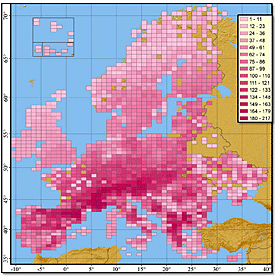Press release from October 5, 2011
Distribution Atlas of Butterflies in Europe
A baseline for the conservation of a core element of biodiversity
Halle/Saale and Berlin. Scientists present the largest distribution data compilation ever on butterflies of an entire continent. The Germany based Society for the Conservation of Butterflies and Moths GfS ("Gesellschaft für Schmetterlingsschutz"), the German Nature Conservation Association NABU ("Naturschutzbund Deutschland") and the Helmholtz-Centre for Environmental Research (UFZ) are delighted to announce the publication of the "Distribution Atlas of Butterflies in Europe".

The Purple Bog Fritillary (Boloria titania) is now mainly found in the Alps and in the mountains of the Balkans and the Baltics. The cold-loving species
is on the Common Bistort(Polygonum bistortum) as their food plant, and thus reacting very sensitively to changes. A "drifting apart" of the butterfly habitat and food plant by
climate change would endanger the species in the future. These cold-loving species may be among the losers of climate change.
Photo: Albert Vliegenthart

Coincidence map showing the distribution and concentration of all European butterfly species (diversity "hotspots" in the mountains of Iberian Peninsula, Alps
and Balkan Peninsula). Every third butterfly species inhabits 1 % or less of the territory of Europe.
Source: Distribution Atlas of Butterflies in Europe. GfS, Halle, Germany.
The atlas was initiated by Otakar Kudrna and is a result of the joint efforts of a team of authors, led by him. It contains full colour distribution maps of all 441 European butterfly species. Apart from providing comprehensive chorological data for taxonomists and biogeographers, the prime purpose of the Atlas is to aid and promote the conservation of European butterflies. The analysis and evaluation of the distribution data, graphically shown on coincidence maps, facilitates the identification of priorities in selecting species and areas of European significance for conservation purposes from a truly European perspective.
Nine years have elapsed since The Distribution Atlas of European Butterflies appeared back in March 2002, the first distribution atlas of the butterflies of any continent. The present book is more than a new edition. The number of data records has almost trebled to about 655.000 and the distribution maps reflect the progress of computer-aided cartographical techniques.
While the atlas from 2002 was the sole work of Otakar Kudrna, progress in different scientific fields now is reflected in the combination of expertise of different colleagues who comprise the author team of the new atlas. This publication was funded through the projects STEP, SCALES and CLIMIT as well as several donors: NABU (Naturschutzbund Deutschland e.V.; Berlin, Germany), Bayerischer Naturschutzfonds (Munich, Germany), Förderverein der Bayerischen Akademie für Naturschutz und Landschaftspflege (ANL; Laufen, Germany), European Interests Group (EIG) of Butterfly Conservation UK (Wareham, UK), De Vlinderstichting (Dutch Butterfly Conservation; Wageningen), and Wissenschaftlicher Verlag & Delta-Druck Peks (Schwanfeld, Germany).
Last but not least is has to be highlighted that the atlas was only possible due to the contributions of 272 volunteers, who provided the basic data. The atlas is expected to serve as baseline for numerous scientific analyses and publications - similar to the "Climatic Risk Atlas of European Butterflies", which was published in 2008 and provided a timely assessment of risks due to the present climate change impacts and thus a contribution for the conservation of butterflies.
Publication:
Otakar Kudrna, Alexander Harpke, Kristian Lux, Josef Pennerstorfer, Oliver Schweiger, Josef Settele, Martin Wiemers (2011).
Distribution Atlas of Butterflies in Europe. GfS, Halle, Germany. 576 pp.
Further Informationen
PD Dr. Josef Settele
GfS / Helmholtz Centre for Environmental Research
Email see www.ufz.de/index.php?de=817
Werner Schulze
NABU
Phone +49 521 336443
WSchulze@entomon.de
or
Tilo Arnhold
Helmholtz Centre for Environmental Research (UFZ)
Public Relations
Phone +49 341 235-1635
tilo.arnhold@ufz.de
Further links
Homepage GfS
www.european-butterflies.ufz.de
Climatic Risk Atlas of European Butterflies
http://pensoftonline.net/biorisk/index.php/journal/article/viewArticle/3
Homepages of the projects CLIMIT, STEP and SCALES
In the Helmholtz Centre for Environmental Research (UFZ) scientists are researching the causes and consequences of far-reaching changes to the environment. They are concerned with water resources, biological diversity, the consequences of climate change and adaptability, environmental and biotechnologies, bioenergy, the behaviour of chemicals in the environment, their effect on health, modelling and social science issues. Their guiding theme: Our research contributes to the sustainable use of natural resources and helps to secure this basis for life for the long term under the effects of global change. The UFZ employs 1,000 people in Leipzig, Halle and Magdeburg. It is financed by the federal government, Saxony and Saxony-Anhalt.
The Helmholtz Association contributes towards solving major and pressing social, scientific and economic issues with scientific excellence in six research areas: Energy, Earth and Environment, Health, Key Technologies, Structure of Matter and Aeronautics, Space and Transport. The Helmholtz Association is Germany’s largest scientific organisation with over 30,000 employees in 17 research centres and an annual budget of approximately 3 billion euros. Its work stands in the tradition of the naturalist Hermann von Helmholtz (1821-1894).
